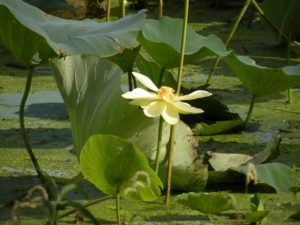
Non-Herbicide Management Options
1. Physical Management Options
American lotus can be cut and removed, but it is difficult to control physically because it can re-establish from seeds and rhizomes.
2. Biological Management Options
At this time, there is no available biological control for American lotus.
Herbicide Control Options
Always read the product label for directions and precautions, as the label is the law. Click on the name of the product to see the label. Read the label for specific water use restrictions.
The active ingredients that have been successful in treating American Lotus include:
- 2,4-D (Rated: Excellent)
- Endothall (Rated: Good)
- Triclopyr (Rated: Excellent)
- Glyphosate (Rated: Good)
- Imazamox (Rated: Good)
- Fluridone (Rated: Excellent)
- Penoxsulam (Rated: Good)
- Florpyrauxifen-benzyl
These rating are based upon the U.S. Army Corps of Engineers aquatic herbicide trials.
1) 2,4-D
2,4-D compounds are systemic herbicides. Systemic herbicides are absorbed and move within the plant to the site of action. Systemic herbicides tend to act more slowly than contact herbicides.
Common trade or product names include but are not limited to:
2) Endothall
Dipotassium salts of endothall come in both liquid and granular form. It can be mixed with copper compounds for additional effectiveness. Contact herbicides act quickly and kill all plant cells that they come into contact with.
Common trade and product names include but are not limited to:
Alkyl amine salts of endothall come in both liquid and granular form. It is a contact herbicide.
Common trade and product names include but are not limited to:
Hydrothol can be toxic to fish.
3) Triclopyr
Liquid triclopyr formulation is a selective broadleaf, systemic herbicide. Systemic herbicides are absorbed and move within the plant to the site of action. Systemic herbicides tend to act more slowly than contact herbicides. An aquatically registered surfactant (see the label) will improve the effectiveness of triclopyr.
Common trade or product names include but are not limited to:
4) Glyphosate
Liquid glyphosate formulations have been effective on American lotus. It is a broad spectrum, systemic herbicide. Systemic herbicides are absorbed and move within the plant to the site of action. Systemic herbicides tend to act more slowly than contact herbicides. An aquatically registered surfactant (see the label) will have to be added to the glyphosate solution for good results.
Common trade or product names include but are not limited to:
5) Imazamox
Imazamox is a broad spectrum, systemic herbicide. Systemic herbicides are absorbed and move within the plant to the site of action. Systemic herbicides tend to act more slowly than contact herbicides. An aquatically registered surfactant (see the label) is needed for application.
Common trade or product names include but are not limited to:
6) Fluridone
Fluridone is a broad spectrum, systemic herbicide. Systemic herbicides are absorbed and move within the plant to the site of action. Systemic herbicides tend to act more slowly than contact herbicides.
Common trade and product names include but are not limited to:
7) Penoxsulam
Penoxsulam is a broad spectrum, systemic herbicide. Systemic herbicides are absorbed and move within the plant to the site of action. Systemic herbicides tend to act more slowly than contact herbicides. It may be sprayed directly onto emergent plants or applied directly into the water. Penoxsulam should not be applied in areas where it will be diluted rapidly. This herbicide will need a registered surfactant (see the label) for leaf and exposed sediment applications.
Common trade and product names include but are not limited to:
8) Florpyrauxifen-benzyl
Florpyrauxifen-benzyl is a systemic herbicide. Systemic herbicides are absorbed and move within the plant to the site of action. Systemic herbicides tend to act more slowly than contact herbicides.
Common trade and product names include but are not limited to:
Currently, ProcellaCOR EC is only available through SePRO Stewards of Water who are PRO Certified as ProcellaCOR Specialists.
Precautions
One danger with any chemical control method is the chance of an oxygen depletion after the treatment caused by the decomposition of the dead plant material. Oxygen depletion can kill fish in the pond. If the pond is heavily infested with weeds, it may be possible (depending on the herbicide chosen) to treat the pond in sections and let each section decompose for about two weeks before treating another section. Aeration, particularly at night, for several days after treatment may help control the oxygen depletion.
One common problem in using aquatic herbicides is determining area and/or volume of the pond or area to be treated. To assist you with these determinations see SRAC #103 Calculating Area and Volume of Ponds and Tanks.
Many aquatically registered herbicides have water use restrictions (See General Water Use Restrictions).
Cultivation Options
American lotus can be propagated by scattering the seeds during fall or winter into shallow, clear water over silty soil. American lotus seeds can stay viable for many years and can be germinated in room temperature, nonchlorinated water after the seed coating is gently removed. New plants can be produced quickly by sectioning the rhizomes into sections, no more than 2 to 3 inches long, of parent plants. These sections can then be placed in wide, shallow containers that are roughly two thirds full with a damp soil mixture and submerged so the water depth is 2 to 4 inches before reaching the soil. The rhizome section should be gently submerged into the soil until little to no portions of the rhizome can be seen. Propagation success will be evident as leaves begin to form.
Questions?
If you need assistance, contact the ag & natural resources agent in your county or hire a professional.